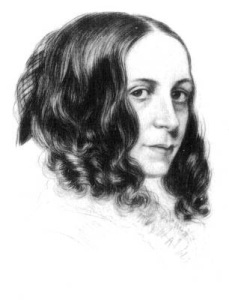How do I love thee? Let me count the ways.
I love thee to the depth and breadth and height
My soul can reach, when feeling out of sight
For the ends of being and ideal grace.
I love thee to the level of every day’s
Most quiet need, by sun and candle-light.
I love thee freely, as men strive for right.
I love thee purely, as they turn from praise.
I love thee with the passion put to use
In my old griefs, and with my childhood’s faith.
I love thee with a love I seemed to lose
With my lost saints. I love thee with the breath,
Smiles, tears, of all my life; and, if God choose,
I shall but love thee better after death.

Valentine’s day can be a time for cliches, commercialisation and churlish rage. I’m not going for cynicism today though, instead I’m going to revel in one of the most perfect love poems ever written. Number 43 in the Barrett Browning’s sequence ‘Sonnets from the Portuguese’ is an enduring favourite and I defy anyone to read it and remain unmoved.
It’s just too tempting to go with a list of how much I adore this poem, though I know my maths will end up being faulty because a short blog post can never do full justice to this most powerful of love poems.
I love this poem because:
1. It was the first non-Shakespearean sonnet I ever read. In fact, as a teenager, I’m afraid this poem made me somewhat dismissive of Shakespeare and his choice of an ‘easier’ form. I like to think I’ve grown up since then, and have realised that it’s possible to like more than one poet within the literary canon, but my point about the complexity of the structure still stands. Sonnets contain 14 lines and the Elizabethans grouped these into three quartets followed by a rhyming couplet. This means the poem is naturally split up into short sections, each contained by the rhymes (ABBA or ABAB). It is also much easier if you’re writing in English, a language which has few suffixes, because you only need to rhyme one end word with one other end word. Overall, you need seven pairs of words that rhyme to make up your sonnet (I realise it’s more complex than that, but I’m a terrible poet and all of my attempts at sonnets have been made up of trying to crowbar rhymes into the right place). The Petrarchan sonnet form is much more fluid, with an octet followed by a sestet and only four or five rhymes in total. This information is about the head not the heart though, Barrett Browning uses the highly restricted form to allow ideas to flow seamlessly from line to line. Progression is delicate, often through half rhymes, and shows a poetic voice luxuriating in emotion. Though it jumps across time, from childhood till ‘after death‘, the poem also displays how this depth of feeling has only slowly built up, through almost imperceptable changes, while still maintaining its initial state. The very structure demonstrates the endurance and permanence of love. It’s utterly brilliant.
2. The politics. Every time I read this poem it gives me something new, but one idea that has really stuck with me is the way Barrett Browning takes a very male poetic form and shows a woman can do it as well, if not better. To go back to Petrarch, his poems were all about Laura, a woman he saw in church and quite possibly never even spoke to. He may have invented the sonnet, but it’s always felt a bit self-indulgent to me, and somewhat dismissive of the original woman who only gets to be mythical inspriation rather than an agent in her own right. Of course, Barrett Browning’s poem could also be accused of self-indulgence (using ‘I’ or ‘my’ sixteen times, to nine ‘thee’s). Firstly, I don’t think it is self-indulgent, it states clearly that it’s an exploration of love and not the beloved. Secondly, it shows that women can write poetry that is as complex, as deep and as powerful as men. This shouldn’t be a triumph, but it is.
3. The images. I simply cannot pull out a favourite line from this poem, I’d just end up quoting the whole piece all over again. Every single image is sublime, from the definition of ‘freedom‘ to the most perfect description of childhood passion I’ve ever read. This is romantic love at its most philosophical and intellectualised, and yet it flows so beautifully (see point 1) and seems so effortless (see point 2). Forget the commercialisation, I’m delighted that I remembered it’s Valentine’s Day and so had an excuse to spend time with my absolute favourite love poem.



Ah thank you! In the midst of the tacky Valentines Day massacre of all things ‘amour’, your post shines out like a beacon of loveliness. 🙂
It’s easy to be cynical about the day – but never about this poem!
Lovely, Shoshi! I totally agree about Barrett Browning giving a female voice to a form that usually silences women, like Petrarch’s Laura. A celebration of love and female independence 🙂
I know, and it adds so much to the romance!
This is such a beautiful sonnet… I agree with you in your statements concerning the poem being more an exploration of love and not just focused on the beloved.
You are right as to the definition of ‘freedom‘, too… very compelling, indeed.
Thanks so much for sharing… I will share it on Twitter…. best wishes and happy week. Aquileana 😀
Thank you for the kind comment and I’m really pleased you love the poem too! I think part of the brilliance of the poem is the way it captures emotions besides love, like freedom, purity and childhood. Have a good week!